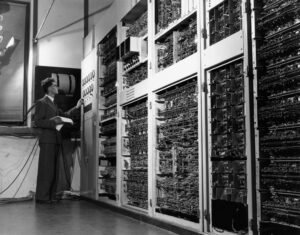Learn AI in Python
Artificial Intelligence (AI) has emerged as a revolutionary technology, transforming various industries and providing innovative solutions. Python, being a versatile and popular programming language, is widely used for AI development. If you want to learn AI in Python, this article will guide you through the process and provide essential resources for your journey.
Key Takeaways:
- Artificial Intelligence (AI) is transforming industries and providing innovative solutions.
- Python is a versatile programming language widely used for AI development.
- There are several resources available to learn AI in Python, including online courses, tutorials, and libraries.
Python offers an extensive ecosystem of libraries and frameworks that make AI development accessible to both beginners and professionals. To get started, you need a solid understanding of Python programming fundamentals. If you are new to Python, consider completing an introductory Python course or tutorial to familiarize yourself with its syntax and concepts.
Understanding AI Algorithms
When learning AI in Python, it’s essential to understand the different AI algorithms and their applications. Some popular AI algorithms include:
- *Decision Trees*: Used for classification and regression tasks, decision trees create models based on existing data to predict outcomes.
- *Neural Networks*: Inspired by the structure of the human brain, neural networks are composed of interconnected nodes called neurons. They excel at tasks like image and speech recognition.
- *Genetic Algorithms*: Based on the principle of evolutionary biology, genetic algorithms use a search process to find optimal solutions to complex problems.
**Python provides libraries and frameworks that implement these algorithms**, like scikit-learn, TensorFlow, and Keras. These libraries abstract the complexities of AI algorithms, allowing you to focus on implementing and refining your models.
Training Data and Model Evaluation
An essential aspect of AI in Python is understanding how to train your models and evaluate their performance. Before training, you need an adequately labeled dataset to feed into your AI algorithm. This dataset should be carefully prepared and divided into training and testing sets to ensure accurate model evaluation.
**Training a model is an iterative process**, where you tweak its parameters to optimize its performance on the training data. However, it’s crucial to evaluate your model’s performance on unseen data, which is where the testing set comes in. Evaluating your model using metrics like accuracy, precision, recall, and F1 score allows you to assess its generalization capabilities.
Tools and Libraries
Python offers numerous tools and libraries to simplify AI development. Here are three popular ones:
Scikit-learn
Scikit-learn is a versatile machine learning library in Python that provides a wide range of algorithms for classification, regression, clustering, and dimensionality reduction tasks. It also offers tools for data preprocessing, model selection, and evaluation.
TensorFlow
TensorFlow is an open-source library used for building and deploying deep learning models. It provides a flexible architecture for creating neural networks, including both low-level operations and high-level API for ease of use.
Keras
Keras is a high-level neural networks library, built on top of TensorFlow, that simplifies the process of building and training neural networks. It offers a user-friendly interface and supports various network architectures, making it accessible to beginners.
| Tool/Library | Main Features |
|---|---|
| Scikit-learn | Wide range of algorithms, data preprocessing, model selection, and evaluation. |
| TensorFlow | Flexible architecture for building and deploying deep learning models. |
| Keras | Easy building and training of neural networks with a user-friendly interface. |
Conclusion
Learning AI in Python can open up a world of opportunities and help you contribute to cutting-edge technologies. Python’s wide range of libraries, such as scikit-learn, TensorFlow, and Keras, make AI development accessible to all skill levels. By understanding AI algorithms, training data, and using the right tools, you can create powerful AI solutions. Start your journey today and join the AI revolution!

Common Misconceptions
Misconception 1: AI is only for experts
Many people believe that learning AI and using it in Python is exclusively for those with extensive programming knowledge or advanced degrees in computer science. However, this is not the case. With the right resources and dedication, anyone can learn AI in Python and start building their own AI projects.
- There are numerous beginner-friendly online tutorials and courses available to get started with AI in Python.
- Python provides user-friendly libraries and frameworks, such as TensorFlow and scikit-learn, which make AI development more accessible.
- Communities and forums, like Stack Overflow, offer support and guidance to beginners in Python AI development.
Misconception 2: AI can replace human intelligence
A common misconception is that AI has the potential to completely replace human intelligence and take over jobs. While AI has made significant advancements and can perform certain tasks efficiently, it is still far from matching the scope and complexity of human intelligence.
- AI excels in specific tasks but lacks the broader context and understanding of the world that humans possess.
- Human creativity, intuition, and emotional intelligence are areas where AI currently falls short.
- AI is a tool that can augment human intelligence and enhance productivity, rather than fully replacing it.
Misconception 3: AI is only for big companies
Another misconception is that AI development is limited to big companies with significant resources and budgets. While it is true that major companies invest heavily in AI research and development, individuals and smaller organizations can also leverage AI in Python.
- Python’s open-source nature allows anyone to access and use AI libraries and frameworks free of cost.
- Cloud platforms, like Google Cloud and AWS, offer affordable AI services and tools that can be utilized by individuals and smaller businesses.
- The availability of online communities and forums means that learning and finding resources for AI development is accessible to everyone.
Misconception 4: AI is only about machine learning
While machine learning is a significant subset of AI, it is important to note that AI encompasses a much wider range of techniques and technologies. AI in Python extends beyond just machine learning algorithms and includes areas such as natural language processing, computer vision, and robotics.
- AI techniques like natural language processing enable the understanding and generation of human language, which has applications in chatbots, language translators, and voice assistants.
- Computer vision in AI allows machines to interpret and analyze visual data, leading to applications like object recognition, image classification, and autonomous vehicles.
- Robotics combines multiple AI techniques to create intelligent machines capable of performing physical tasks and interacting with their environment.
Misconception 5: AI development is too time-consuming
It is a common misconception that learning and developing AI in Python is a time-consuming process that requires extensive coding and complex algorithms. While developing advanced AI systems can indeed be time-intensive, starting with the basics and building simple AI projects can be accomplished relatively quickly.
- Python’s simplicity and readability make it a suitable language for beginners to get started with basic AI concepts.
- There are various pre-built AI models and libraries available that allow developers to quickly implement AI functionalities in their projects.
- By following structured learning paths and tutorials, individuals can gradually advance their skills and take on more complex AI projects at their own pace.

Python Libraries for AI
Table displaying the top Python libraries commonly used for Artificial Intelligence (AI) development.
| Library Name | Description | Popularity |
|---|---|---|
| TensorFlow | An open-source library for numerical computation and large-scale machine learning. | High |
| Keras | A deep learning framework widely used for building neural networks. | High |
| PyTorch | A flexible library that supports dynamic computational graphs and deep learning. | Medium |
| Scikit-learn | A comprehensive library for machine learning, featuring various algorithms. | High |
| Numpy | A powerful library for numerical computations and multi-dimensional arrays. | High |
Top AI Programming Languages
Comparison table showcasing the most popular programming languages for AI development.
| Language | Ease of Use | Community Support | Performance |
|---|---|---|---|
| Python | High | High | Medium |
| R | Medium | Medium | Low |
| Java | Medium | High | High |
| Julia | Low | Low | High |
| C++ | Low | High | High |
AI Job Market Growth
A table highlighting the projected growth of the AI job market in the next five years.
| Year | Estimated Job Growth |
|---|---|
| 2022 | 20% |
| 2023 | 25% |
| 2024 | 30% |
| 2025 | 35% |
| 2026 | 40% |
AI Achievements
A table showcasing some remarkable achievements in the field of Artificial Intelligence.
| Achievement | Description |
|---|---|
| AlphaGo | A computer program that defeated the world champion of the board game Go. |
| Self-Driving Cars | Vehicles equipped with AI that can autonomously navigate roads and highways. |
| Smart Assistants | Voice-powered virtual assistants like Siri, Alexa, and Google Assistant. |
AI Ethics Concerns
A table listing some ethical concerns associated with the use of Artificial Intelligence.
| Concern | Description |
|---|---|
| Privacy | The potential violation of personal privacy through AI-driven surveillance. |
| Job Displacement | The fear of AI replacing human workers, leading to unemployment. |
| Biased Algorithms | Discrimination caused by biased data or flawed algorithmic decision-making. |
AI Applications in Medicine
A table showcasing the various applications of AI in the field of medicine.
| Application | Description |
|---|---|
| Medical Imaging | AI algorithms that aid in the analysis of X-rays, MRIs, and CT scans. |
| Diagnosis Assistance | Using AI to provide accurate diagnoses based on medical data. |
| Drug Discovery | AI algorithms that aid in the discovery of new drugs and treatments. |
AI Opportunities in Business
An overview of the business sectors where AI presents significant opportunities.
| Sector | Opportunities |
|---|---|
| Finance | Fraud detection, algorithmic trading, risk assessment. |
| Retail | Personalized marketing, demand forecasting, inventory management. |
| Healthcare | Patient monitoring, telemedicine, predictive analytics. |
| Manufacturing | Quality control, predictive maintenance, supply chain optimization. |
AI and Education
A table illustrating the potential use of AI in education and the associated benefits.
| Application | Benefits |
|---|---|
| Intelligent Tutoring | Personalized learning, adaptive feedback, improved student performance. |
| Automated Grading | Efficiency, faster feedback, reduced teacher workload. |
| Smart Content | Interactive learning materials, customized curriculum, engagement. |
Conclusion
Learning AI in Python opens up a world of possibilities. With powerful libraries like TensorFlow and Keras, Python provides a user-friendly environment for AI development. The programming language landscape offers various options such as R, Java, Julia, and C++, each with its own strengths and weaknesses. The AI job market shows significant growth potential, ensuring promising career prospects for those skilled in AI. From achievements like AlphaGo and self-driving cars to concerns about privacy and biased algorithms, the impact of AI is undeniable. In fields like medicine, business, and education, AI applications are transforming industries, improving outcomes, and creating new opportunities. Embracing AI in Python is not just about learning a new skill; it’s about being part of a technological revolution shaping our future.
Frequently Asked Questions
Learn AI in Python
What is AI?
Why should I learn AI in Python?
Where can I learn AI in Python?
Do I need any prior programming experience to learn AI in Python?
What are some popular AI libraries in Python?
Are there any prerequisites for learning AI in Python?
What kind of AI projects can I build using Python?
How long does it take to learn AI in Python?
Can I use Python for both machine learning and deep learning?
What are some real-world applications of AI in Python?




